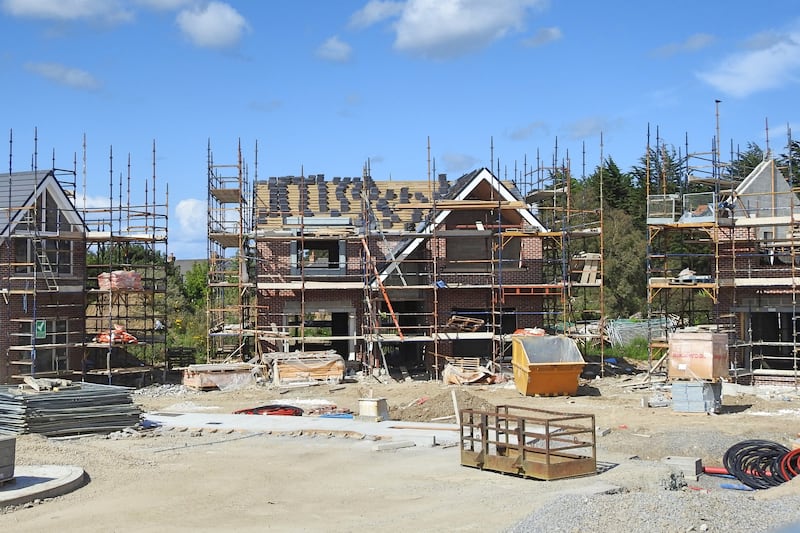Niamh McCann is an artist whose work includes sculpture, installation, video and painting. After a foundation course in NCAD she completed a BA in Fine Art with the Crawford College of Art and Design in Cork before an MA in Fine Art/Combined Media at Chelsea College of Art and Design, London.
Her work has been exhibited all over the world, including the US, China and much of Europe.
Originally from Rathfarnham, she moved into her Dublin 8 home five years ago. She shares it with her partner, poet Annemarie Ní Churreáin, and Sophie, their Staffordshire bull terrier.
Describe your interior style
I don’t have one word to define my style; it is not how I think about it. I tend to surround myself with what I want, what I need and what I like.
When I lived here first, I had no furniture. A friend of mine, Audrey, who runs her own furniture restoration business, arrived one day with a gorgeous oak table. Another friend, Kushla, discovered two ruby red rocking chairs for €30 in a little second-hand store called Busy Bees, which is sadly not around today. I was happy to do that – to live with very little furniture – until I fell across items that I genuinely liked very much.
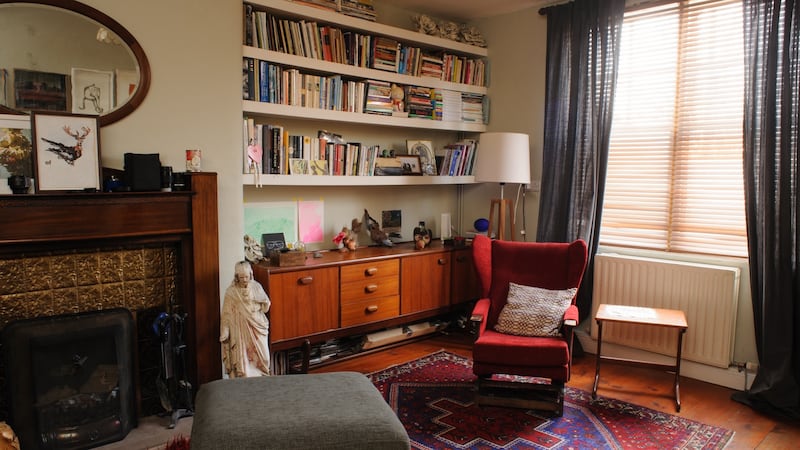
My Danish “day bed” couch is actually one of the few items I made an effort to search for. I was looking for something that would both fit this space exactly and that was aged slightly. Luckily I found a guy online who specialised in selling old “found” pieces. It’s not very practical as a day bed, but it is comfortable. I repurposed a step ladder from an old studio. Everything is usable – every space in this house is maximised.
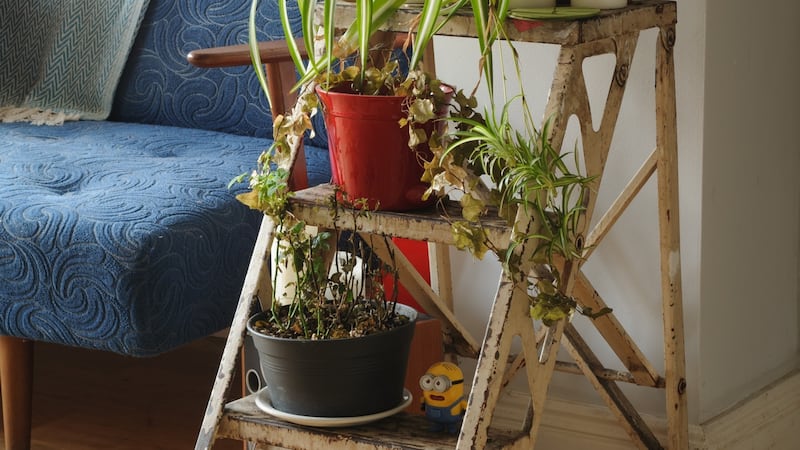
The stepladder has become a display space for roses, Busy Lizzies, an unhealthy rubber plant – it's practically impossible to kill those things. The red cushions on the couch were a gift. I'm partial to geometric design.
It is almost an exaggeration to say that I made the kitchen table, because it is so simple an object – a table top with A-frame legs. The table surface is OSB board, sealed with water-resistant wood paint and is, in fact, an off-cut from pieces of work. I knew the size I needed, so I fitted in a table top while making the artwork. I loved my previous table because it was gifted to me by Audrey, but we needed something wider for entertaining guests. I suppose I’m always conscious of how best a space can be used and I wanted to be able to share food in a relaxed, un-crammed way.
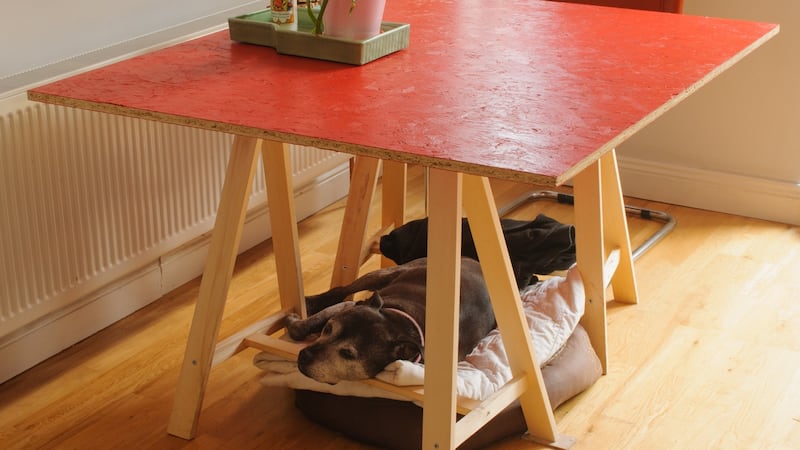
What room do you most enjoy?
Right now, this room [kitchen/living area] probably gets used most and therefore I enjoy it most, because it’s both the living and working room. We work on our laptops at this table, or I use it to make artwork, as much as we eat or share food with friends here. That said, the front living room is very cosy for fires in winter and for lounging around in with a book.
Which items do you love the most?
A tray that my friend Kushla gifted to me when she was dismantling her home and moving back to New Zealand. I have a number of really beautiful, once-off pieces from Kushla. She is one of the people in my life who has an eye for beautiful things. Much of what I own is precious to me because of the emotional attachment. Lots of the bits and pieces in this house mean something to me because of who they have previously belonged to.
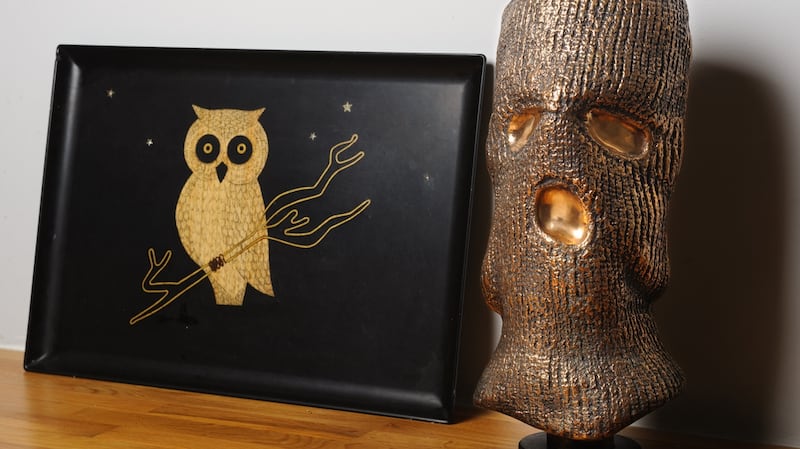
A bronze balaclava that is very likely going into the Hugh Lane Gallery show in October 2018. It's quite an unusual kitchen presence. As an artwork it refers to material figures or monuments that feel familiar to us, and are immediately recognisable within both the local and international landscape. The balaclava has particular associations – but it's also a woolly hat. Its meaning lies somewhere in between amicable and threatening – it's both cute and attractive and also it carries with it all the darkness of a mask. All through our lives we're invited, and often instructed, to mask ourselves.
The Virgin Mary in the living room was a gift from Annemarie, who added it to my collection of other saintly statues and religious iconography. They are not religious to me, but they are not irreligious – they're a bit like the balaclava – symbolic and meaningful yet malleable. I am attracted to these kinds of ornaments because of their ambiguity as well as their familiarity. Hanging from that Mary is a Mexican votive. In Mexico these little features are painted as pleas to the saints or the gods or the Marys. They are created to give thanks or to petition the divine forces for certain favours. The Madonna wall is not entirely female and it mostly features heads, semi-revealed bodies and masked figures. These things were once very present and are somehow still very present, but we are in a place now where their original associations are being overlaid with something new. That kind of loss and emergence of altered meaning appeals to me. I enjoy the fact and presence of these changeling items.
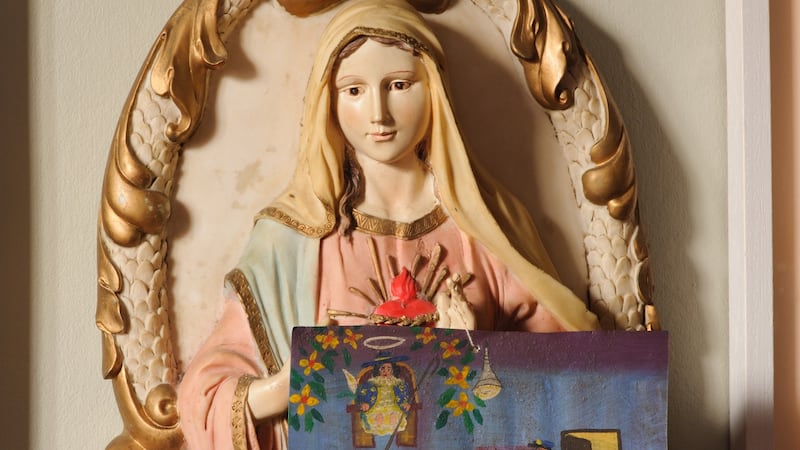
Which artists do you admire?
I think of it as part of my job, part of any artist’s job to be looking, reading and identifying interesting makers and thinkers constantly. Who and what I’m looking at, at a particular moment in time, is often in flux.
However, I consistently return to the work of Francis Alÿs, an artist I really admire for his intertwining of the poetic and the political into works of beautiful material diversity. I appreciate the way he returns over time to certain images and works and tropes.
There are lots of artists in Ireland at the moment with really dynamic and thriving practices. It's a very active place to be as an artist.
Biggest interior turn-off?
If a person’s home or place is a space that gives them pleasure and comfort, then whether or not it is to my taste is not the point. As a creator, I respect the actuality of unique spaces. In a similar vein, studios are deeply personal and unique spaces. It’s not for me to prescriptively think about another person’s home that way; everybody is different. Taste is a slippery and loaded concept. Are pencil drawings better than paintings? They can both be good. Spaces of different interior tastes can be equally good.
Travel destination that stands out?
I am a traveller as opposed to a holidayer, which effectively means that I’m most often on the road with work. I am usually either drawn to destinations by the work itself or often by the learning or research possibilities of a place. I am always trying to benefit myself as an artist; benefit the work, to learn, to find space to make things. For me travel is about expanding my potential as a maker.
I was in Brussels at the start of this year for a short production residency at Penthouse Artist Residency. I found it to be a very rich city culturally – much more so than I had expected. I also spent some time recently in Copenhagen and really liked the atmosphere there. As a city not much bigger than Dublin, its proximity to the sea made an impression on me – and the light in particular. Finland and Brussels have a similar white, grey heaviness to their skies. I love the quality of light in Ireland. The skies tend to be more expansive and even in winter the colours, diverse.
If you had €100,000 to spend on anything for the home, what would it be?
Honestly, I would not use much of it on the purchase of objects. I’d be thinking of other ways to spend it. By spend I mean invest but according to the broadest most creative definition of that word. If one has €100,000 to spend freely, then there are a series of questions and conversations as well as reflections that need to be had. What would I do? I’d make decisions about it slowly. My living space is not something I have ever spent a huge amount of finance on. It’s not who I am. Seriously, I’d find it impossible to spend €100,000 furnishing a house; €100,000 is or should be a house. Essentially, all my favourite furnishings are created, restored or found.
Niamh McCann's forthcoming exhibition Furtive Tears opens on the 4th of October 2018 in the Hugh Lane Gallery. www.niamhmccann.com





















